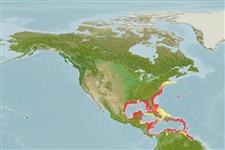Environment: milieu / climate zone / depth range / distribution range
Ecology
Marine; demersal; depth range 9 - 91 m (Ref. 7251), usually 10 - 60 m (Ref. 5217). Subtropical; 46°N - 6°N, 98°W - 56°W
Western Atlantic: Nova Scotia, Canada and Bermuda to Guyana. Rare north of Florida, USA; absent from Bahamas.
Size / Weight / Age
Maturity: Lm ? range ? - ? cm
Max length : 25.0 cm TL male/unsexed; (Ref. 7251); 27.0 cm TL (female); common length : 16.0 cm TL male/unsexed; (Ref. 3792); max. published weight: 0.00 g
Dorsal spines (total): 9; Dorsal soft rays (total): 8; Anal spines: 2; Anal soft rays: 6. Red to reddish dorsally, grading to whitish ventrally, with 2 to 5 longitudinal yellow stripes that are generally not sharply defined. First dorsal fin with 2 orange to red stripes, the outer part of fin sometimes blackish. Second dorsal fin with 4 or 5 narrow reddish stripes. Caudal fin reddish. Snout short, the dorsal profile steep, forming an angle of about 60º and nearly straight. Interorbital space broad and flat. Teeth very small, in a villiform band in lower jaw, none in upper jaw. No spine in opercle (Ref 52648).
Inhabits neritic waters, especially over sand or mud bottoms (Ref. 5217). Flesh considered excellent quality; marketed fresh (Ref. 3792).
Life cycle and mating behavior
Maturity | Reproduction | Spawning | Eggs | Fecundity | Larvae
Robins, C.R. and G.C. Ray, 1986. A field guide to Atlantic coast fishes of North America. Houghton Mifflin Company, Boston, U.S.A. 354 p. (Ref. 7251)
IUCN Red List Status (Ref. 130435: Version 2024-2)
Threat to humans
Harmless
Human uses
Fisheries: minor commercial
Tools
Special reports
Download XML
Internet sources
Estimates based on models
Preferred temperature (Ref.
123201): 22.9 - 28, mean 25.6 °C (based on 480 cells).
Phylogenetic diversity index (Ref.
82804): PD
50 = 0.5625 [Uniqueness, from 0.5 = low to 2.0 = high].
Bayesian length-weight: a=0.01023 (0.00493 - 0.02126), b=3.10 (2.93 - 3.27), in cm total length, based on LWR estimates for this (Sub)family-body shape (Ref.
93245).
Trophic level (Ref.
69278): 3.4 ±0.3 se; based on size and trophs of closest relatives
Resilience (Ref.
120179): Medium, minimum population doubling time 1.4 - 4.4 years (Preliminary K or Fecundity.).
Fishing Vulnerability (Ref.
59153): Low vulnerability (17 of 100).
